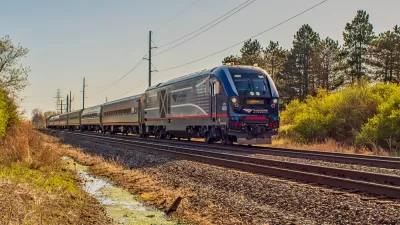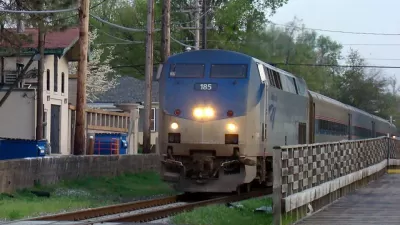House Republicans object to further funding of the High-Speed Intercity Passenger Rail program - largely due to California's expectation to receive $42 billion in federal funding - yet less ambitious projects have shown much promise.
The "High-Speed Intercity Passenger Rail (HSIPR) program hasn’t received funding since 2010", writes Ryan Holeywell, a result of "a budget deal struck with Republicans in April 2011." Ironically, a problem with restoring the funding lies with the one remaining true high speed rail project in the nation after Florida Gov. Rick Scott rejected $2.4 billiion of federal funding for the much more limited, and highly achievable, 84-mile Tampa to Orlando project in Feb., 2011.
HSR opponents have fixated on the $42 billion that the California High Speed Rail Authority expects to receive from the federal government for its $68.5 billion, 800-mile project linking northern and southern California with 220-MPH trains. Holeywell captured this "tense exchange" between Transportation Secretary Ray LaHood and Rep. Jeff Denham, a Republican representing California’s Central Valley who "chairs the House subcommittee overseeing rail" who asked where the federal funds would come from.
“We’re not going to get one dollar as long as there’s language in appropriation bills that says no federal money can be spent on California high-speed rail,” replied an agitated LaHood, referring to an amendment Denham had championed last year. “That doesn’t help us.”
Other, less ambitious, less costly projects that have received HSIPR funding have gone forward that upgrade existing lines, such as trains reaching 110 MPH linking Chicago and St. Louis (reported here last year),
And in the Seattle-Portland corridor, there will soon be six round-trip trains per day, up from four; officials there say the uncertain future of federal funding won’t undo that work.
Referring to the California project and Amtrak's $151 billion plan for Northeast Corridor, "Emil Frankel, a visiting scholar at the Bipartisan Policy Center who served as assistant secretary for transportation policy under George W. Bush asked, “Where’s the money going to come from? In balancing the demands of the federal budget -- let alone state budgets -- it’s just impossible to imagine.”
As for the $40 billion in rail investment in President Obama's budget, Holeywell writes, "It’s become a routine occurrence, but such grand proposals for rail expenditures have increasingly rung hollow."
FULL STORY: Has High-Speed Rail Been Derailed?

Study: Maui’s Plan to Convert Vacation Rentals to Long-Term Housing Could Cause Nearly $1 Billion Economic Loss
The plan would reduce visitor accommodation by 25,% resulting in 1,900 jobs lost.

North Texas Transit Leaders Tout Benefits of TOD for Growing Region
At a summit focused on transit-oriented development, policymakers discussed how North Texas’ expanded light rail system can serve as a tool for economic growth.

Why Should We Subsidize Public Transportation?
Many public transit agencies face financial stress due to rising costs, declining fare revenue, and declining subsidies. Transit advocates must provide a strong business case for increasing public transit funding.

How to Make US Trains Faster
Changes to boarding platforms and a switch to electric trains could improve U.S. passenger rail service without the added cost of high-speed rail.

Columbia’s Revitalized ‘Loop’ Is a Hub for Local Entrepreneurs
A focus on small businesses is helping a commercial corridor in Columbia, Missouri thrive.

Invasive Insect Threatens Minnesota’s Ash Forests
The Emerald Ash Borer is a rapidly spreading invasive pest threatening Minnesota’s ash trees, and homeowners are encouraged to plant diverse replacement species, avoid moving ash firewood, and monitor for signs of infestation.
Urban Design for Planners 1: Software Tools
This six-course series explores essential urban design concepts using open source software and equips planners with the tools they need to participate fully in the urban design process.
Planning for Universal Design
Learn the tools for implementing Universal Design in planning regulations.
City of Santa Clarita
Ascent Environmental
Institute for Housing and Urban Development Studies (IHS)
City of Grandview
Harvard GSD Executive Education
Toledo-Lucas County Plan Commissions
Salt Lake City
NYU Wagner Graduate School of Public Service





























